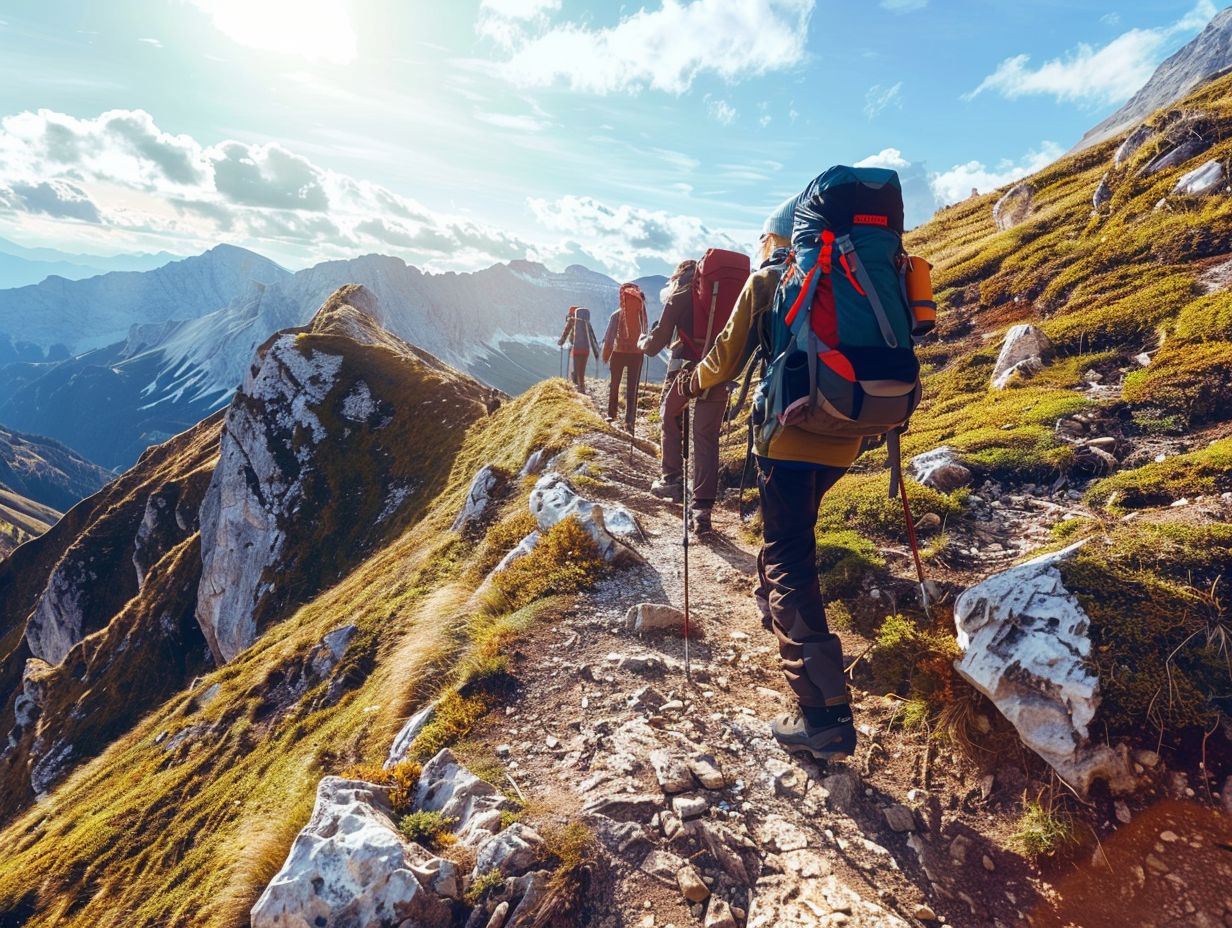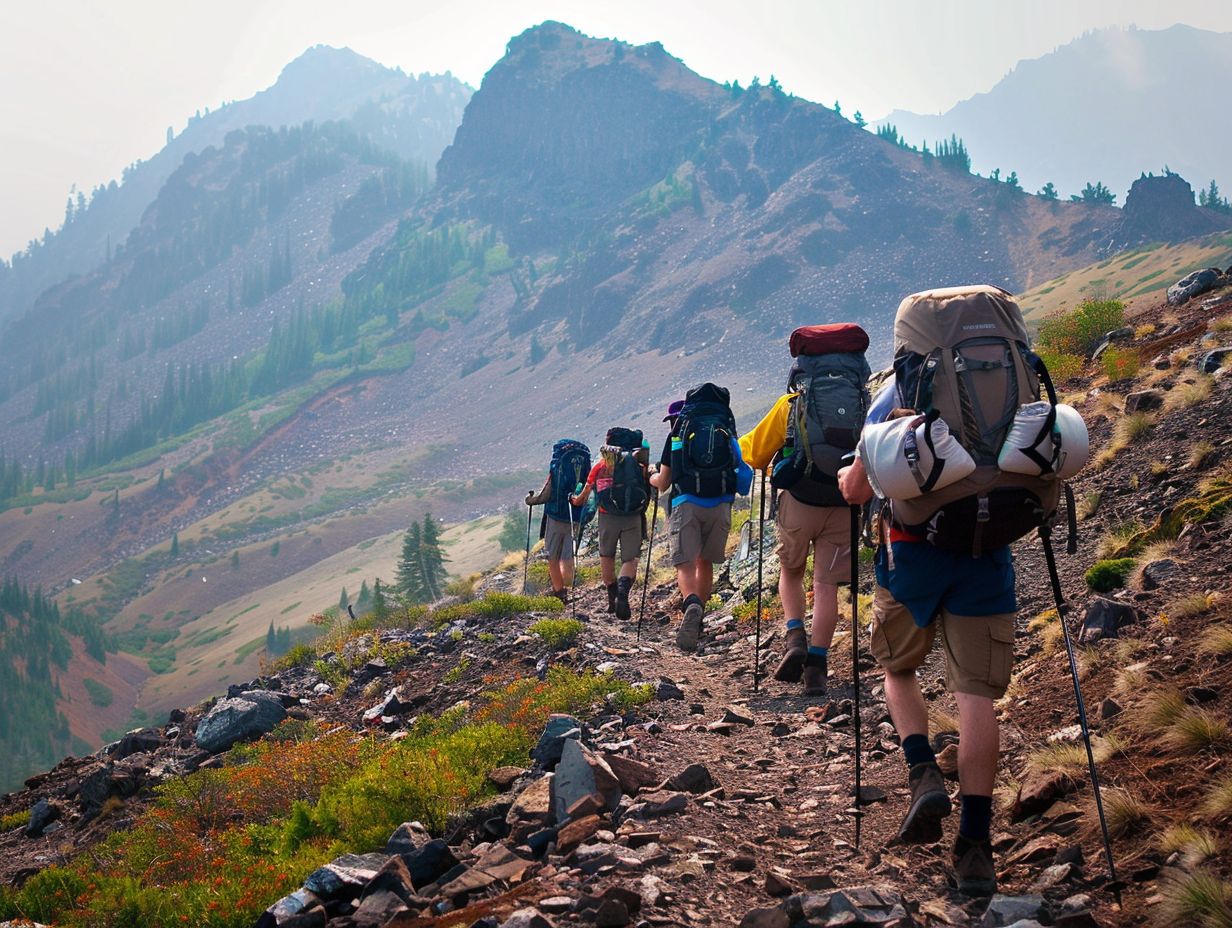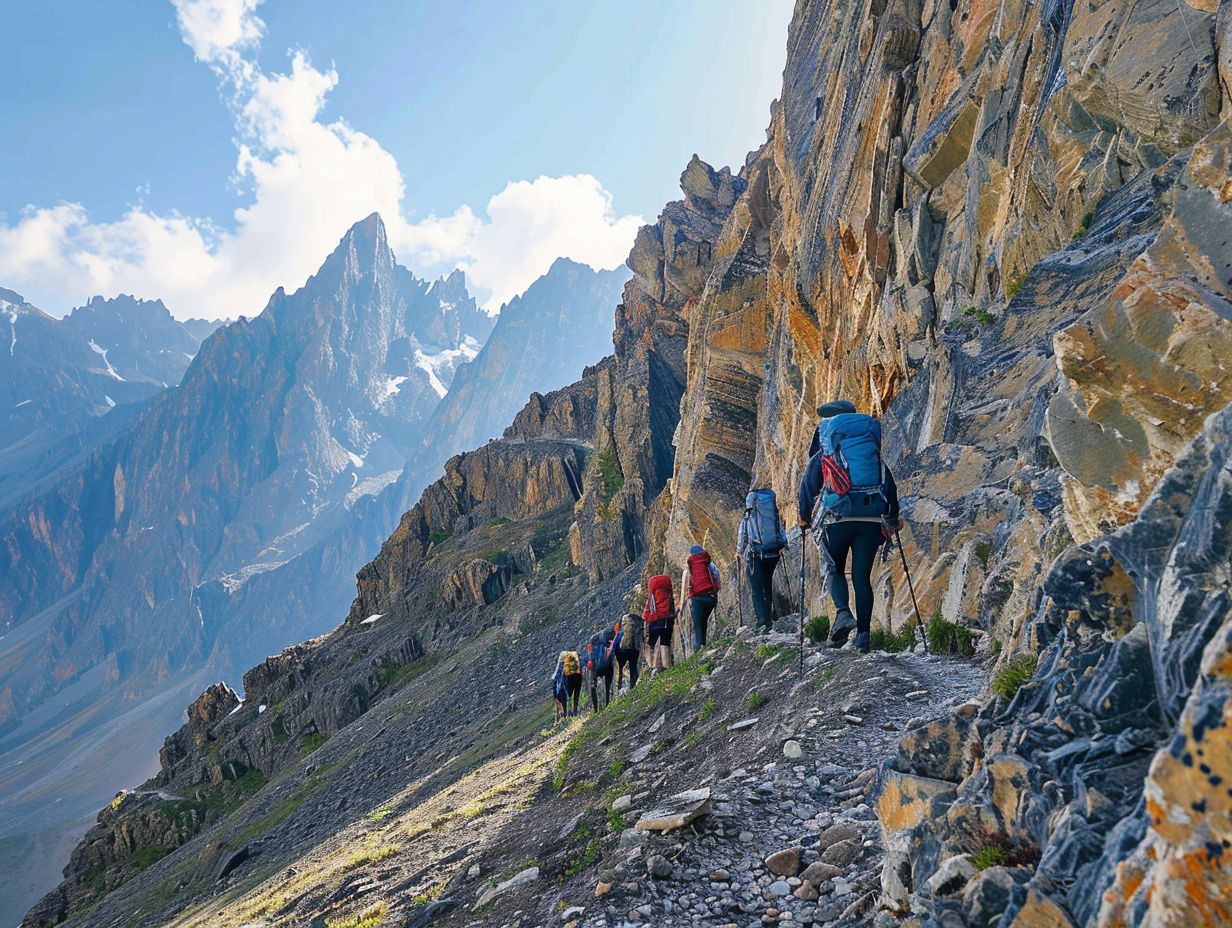If you’re planning a high-altitude hiking adventure, you need to be on top of the potential risks that come with altitude sickness. Find out what altitude sickness is, its symptoms, and how it messes with your body.
Get the lowdown on oxygen levels at different altitudes, when you might need extra oxygen while hiking, and how to gear up for those high-altitude treks.
And of course, pick up some helpful tips on acclimatizing and keeping yourself safe up there in the high altitudes.
What is the Altitude Sickness?
When you’re up in the mountains or at altitudes above 8,000 feet, you might come face-to-face with altitude sickness, also known as acute mountain sickness. This condition is a common companion for adventurers exploring mountainous terrains or enjoying activities like hiking, trekking, and mountain climbing.
As you climb higher, the air pressure drops, meaning there’s less oxygen available for you to breathe in. This oxygen shortage can lead to unpleasant symptoms like headaches, nausea, fatigue, and dizziness. Be mindful, especially if you’re pushing through altitude training or making a rapid ascent to those lofty heights because you’re more likely to experience altitude sickness in these scenarios. In some serious cases, altitude sickness can escalate into conditions like high altitude pulmonary edema or cerebral edema, which demand immediate medical attention. Stay safe out there!
What are the Symptoms of Altitude Sickness?
When you’re up in the mountains at high altitudes, keep an eye out for altitude sickness symptoms. You might start feeling a headache, nausea, dizziness, fatigue, and find yourself huffing and puffing more than usual.
It’s important to catch these signs early to avoid things getting worse. Look out for other symptoms like loss of appetite, trouble sleeping, and just an overall feeling of bleh. Pay attention to these red flags because they could lead to more serious forms of altitude sickness like high-altitude pulmonary edema (HAPE) or high-altitude cerebral edema (HACE), which are no joke and could be life-threatening if you don’t act fast.
Stay tuned in to how your body is handling the high altitudes and take the necessary steps to lower the risks that come with altitude-induced symptoms.
How does Altitude Affect the Body?
When you’re up in the mountains or at high altitudes, your body has to deal with lower oxygen levels because of the decreased atmospheric pressure. This drop in oxygen can cause hypoxia, messing with your respiratory system and forcing your body to adapt to the altitude.
As you climb higher, your body has to get used to the thinner air. Your respiratory system has to work overtime to get enough oxygen to keep you going. Your lungs have to put in extra effort to make up for the lack of oxygen, which can lead to faster breathing and a quicker heartbeat as your body tries to make sure your tissues are getting enough oxygen.
Your body goes through a bunch of changes to deal with the altitude, all aimed at getting more oxygen to your tissues and making sure everything keeps running smoothly despite the tough conditions.
How Does Oxygen Levels Change with Altitude?
As you climb higher, the oxygen levels in the air start to drop because of the lower atmospheric pressure. This change in oxygen availability can be a real challenge for you when you’re trying to get used to those higher altitudes and keep enough oxygen in your system.
When you’re an outdoor enthusiast or a hiker exploring lofty altitudes, acclimatizing to the height is key. If you don’t give your body time to adjust, it can struggle with the reduced oxygen levels, bringing on symptoms of altitude sickness like headaches, dizziness, and nausea. By gradually making your way up to higher altitudes and giving your body the chance to adapt, you’ll make sure that your oxygen levels stay up to scratch for peak performance and well-being on your outdoor escapades.
How Does Altitude Affect Breathing?
Altitude can mess with your breathing, leading to things like high-altitude pulmonary edema, a gnarly form of altitude sickness that messes with your lungs. To steer clear of respiratory issues and other altitude-related illnesses, you gotta manage altitude sickness like a boss.
Keeping hydrated and giving your body time to adjust to the higher altitudes are crucial for handling respiratory problems caused by altitude. Pay attention to signs like feeling out of breath, coughing, or tightness in your chest – these could be signs of high-altitude pulmonary edema creeping in. If things get serious, you might need to hustle down to lower elevations. Training up, taking it slow as you climb, and packing your meds are all smart moves to help lower the risks of altitude sickness when you’re out in the great outdoors.
What is the Recommended Altitude for Hiking?

When you’re hitting the trails, the best altitude for hiking really depends on your own fitness level and how well you handle high altitudes. If you’re just starting out, it’s a good idea to ease into it with low-altitude paths and gradually work your way up to higher elevations. This way, you can get used to the altitude and really enjoy those epic high-altitude treks.
You’ve got to be real with yourself about how you handle different altitudes. Experienced hikers might be looking for some tough mountain trails with killer views and challenging terrain. Knowing how altitude sickness can hit and the importance of acclimatization is key to prepping for your adventure. Remember to take it slow as you climb higher, drink plenty of water, and always pay attention to what your body is telling you. That’s the way to ensure a safe and awesome trekking experience.
What is Considered High Altitude?
When you’re up in those lofty heights, between 8,000 to 12,000 feet above sea level, you might run into some altitude-related hurdles. It’s key to take steps to prevent altitude sickness for a smooth journey to those mountain tops.
Your body needs to adjust to the thin air up there, making physiological changes to handle the lower oxygen levels. To make the transition easier, remember to keep hydrated, take it slow as you climb, and give yourself time to acclimatize. Including foods high in iron and antioxidants can also give your body a boost in adapting.
Watch out for signs like headaches, fatigue, and nausea—they could signal altitude sickness creeping in. Recognizing these symptoms early on can help you get the right help fast and prevent any nasty surprises as you climb higher.
What is Considered Extreme Altitude?
When you’re up there in extreme altitude, above 18,000 feet, that’s when things really start to get intense. The air pressure drops big time, putting you in a tight spot with some serious altitude-related risks. Surviving in these extreme altitudes isn’t a walk in the park – it’s a whole new ball game that you need to be ready for.
Up in those extreme altitudes, the air gets thin real quick. Your body struggles to grab enough oxygen, and that’s when altitude sickness can hit you. It’s not just a simple headache; it can escalate to stuff like pulmonary edema. And don’t forget about the high-altitude challenges like rough weather, tough terrain, and hardly any medical help around. It’s a risky business, for sure.
To make it through those extreme altitudes in one piece, you gotta take it slow and let your body acclimatize. Give yourself time to adjust to the thin air and low oxygen levels up there. It’s all about preventing those life-threatening complications and staying safe.
When Do You Need Oxygen When Hiking?
You might find it necessary to have supplemental oxygen on hand while hiking, especially in cases of altitude sickness emergencies or when oxygen levels are critically low. Having supplemental oxygen with you can be crucial for managing altitude-related health issues and ensuring your safety during high-altitude adventures.
When you’re out in thin air and oxygen levels take a nosedive, you might start feeling dizzy, short of breath, or totally wiped out. That’s when having supplemental oxygen comes to the rescue – it boosts oxygen levels in your body, giving you quick relief from these symptoms.
It’s crucial to carry supplemental oxygen when trekking to altitudes above 8,000 feet, where oxygen saturation naturally drops. Being prepared with supplemental oxygen could save the day in those unexpected emergency situations when altitude sickness hits you out of the blue.
What Factors Affect Oxygen Needs While Hiking?
When you’re hiking, remember that various factors affect your oxygen needs, especially as you make your way up and down different altitudes. Knowing how these changes impact you is key for dealing with altitude sickness and taking care of your lungs while you’re out conquering mountains.
As you climb to higher elevations, keep in mind that the air pressure drops, which means there’s less oxygen in the air. This decrease in oxygen levels can trigger altitude sickness symptoms like headaches, feeling dizzy, and getting worn out.
To help your body get used to the oxygen changes, try acclimatization methods like gradually going up in altitude and keeping yourself well-hydrated. If you start feeling the effects of altitude sickness, heading back down to lower elevations can offer relief and boost your oxygen intake.
Make sure you pay attention to these altitude shifts so you can prevent and handle altitude sickness effectively while you’re out on your hiking adventures.
What Are the Signs That You Need Oxygen While Hiking?

If you’re out hiking and feeling a bit off, keep an eye out for signs that you might need some extra oxygen. Low oxygen levels can be detected with a pulse oximeter, and if you’re showing symptoms of altitude sickness, it’s time to get checked out by a medical professional. Recognizing these signals early is key to managing altitude sickness effectively.
Hikers, don’t forget the importance of a pulse oximeter! This nifty device lets you keep tabs on your oxygen levels as you climb, giving you a heads-up if things start to dip into the danger zone. Detecting these changes quickly is crucial for diagnosing altitude sickness and getting the right treatment. Acting fast can help prevent mild discomfort from turning into serious, life-threatening issues. So, always pack a pulse oximeter and stay alert to any shifts in your oxygen levels when you’re hiking in high-altitude areas.
How to Prepare for High Altitude Hiking?
When getting ready for high-altitude hiking, you need to acclimate yourself to altitude changes, pick out suitable trekking routes, and take necessary precautions to handle altitude-related risks. Good planning and slowly getting used to higher elevations are key to ensuring a safe and fun hiking adventure.
It’s crucial that you acclimate to altitude because it helps your body adjust to the lower oxygen levels at higher altitudes. It’s a good idea to spend some time at moderate altitudes before moving up to prevent altitude sickness.
When you’re choosing high-altitude trekking routes, think about things like how much altitude you’ll gain each day, how challenging the terrain is, and how easily you can access emergency services. Don’t forget to pack important gear like altitude sickness medication, extra layers, and a first aid kit.
Always put safety first and make sure to tell someone about your hiking plans. It’s better to be safe than sorry!
What Are the Precautions for High Altitude Hiking?
When preparing for high-altitude hiking, you need to take some precautions to ensure a safe and enjoyable adventure. Acclimatization strategies, preventive measures for altitude sickness, and prioritizing hiking safety are key to minimizing altitude-related health risks.
High-altitude hiking throws some unique challenges your way, so you’ve got to be prepared. Preventing altitude sickness means taking it slow, keeping yourself hydrated, and fueling up with a good mix of carbs and electrolytes. Keep an eye out for symptoms like headaches, nausea, and fatigue, and make sure to act fast if you notice anything off.
If you do start feeling the effects of altitude sickness, the best move is to descend to lower elevations and get medical help if things get worse. It’s also a good idea to have essential medications like acetazolamide on hand. Plus altitude sickness prevention, remember to follow general hiking safety tips like wearing the right gear, packing navigation tools, and letting someone know your hiking plans. These steps are crucial for a successful and secure mountain trek.
What Are the Tips for Acclimatizing to High Altitude?
To acclimatize to high altitude effectively, you need to ease yourself into those lofty heights. Start by gradually exposing yourself to elevated terrains, keeping yourself hydrated, and using acclimatization techniques like controlled ascents. Acclimatization is key to helping your body adjust to changes in altitude and lowering the risk of altitude-related illnesses when you’re out on your outdoor escapades.
As you spend more time at higher altitudes, your body gets used to the thinner air and reduced oxygen levels. Remember to stay hydrated consistently because dehydration can make altitude sickness worse. Try out specific acclimatization methods like the ‘climb high, sleep low‘ approach. This means trekking up during the day but heading back down to lower altitudes to rest, which helps your body adapt. Watch how you’re feeling and adjust your pace as needed to ensure a safe and successful altitude acclimatization journey.
Frequently Asked Questions
At what altitude do you need oxygen when hiking?

It is recommended to start using supplemental oxygen when hiking above 8,000 feet.
Do I need to carry oxygen with me when hiking at high altitudes?
If you are planning to hike above 12,000 feet, it is recommended to carry supplemental oxygen with you as a precaution.
What are the signs that I need to use oxygen while hiking?
If you experience shortness of breath, dizziness, or fatigue while hiking at high altitudes, it is a sign that you may need to use supplemental oxygen.
Can I acclimatize to high altitudes and avoid using oxygen while hiking?
While it is possible to acclimatize to high altitudes, it is not guaranteed for everyone. Using supplemental oxygen can help prevent altitude sickness and make your hike more enjoyable.
Can I use oxygen intermittently while hiking?
Yes, you can use oxygen intermittently while hiking at high altitudes. It is recommended to take breaks and use oxygen during strenuous parts of your hike to help prevent altitude sickness.
Is it safe to use oxygen while hiking?
Yes, it is safe to use supplemental oxygen while hiking. However, it is always best to consult with a doctor before using any type of supplemental oxygen during physical activities.

